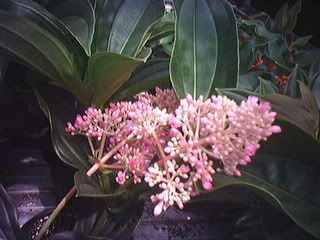
Bright, diffuse sun is ideal for Medinilla. These plants grow epiphytically in trees and so are accustomed to some protection. If you are in the northern hemisphere, the best place to keep your Medinilla is near a southern window with a sheer curtain on it. Make that a northern window if you are south of the equator. Otherwise, an eastern or western window is a good choice.
Epiphytes do not need potting soil to grow, but of course if you are going to grow it indoors, you’ll want to pot it up in some. Avoid using a cheap potting mix as they tend to be very heavy and do not allow good drainage, something Medinillas absolutely must have. Choose instead a high quality mix and add some coarse materials such as orchid bark, charcoal and perlite.
Water your Medinilla regularly, letting the potting mix dry out about an inch and a half down between waterings. Water thoroughly with tepid water, making sure that liquid makes it all the way through and out of the bottom of the pot. You’ll want to use a liquid fertilizer at every other watering.
Medinilla is propagated from seed or cuttings. Many people claim greater success when propagating from seed as cuttings require very high humidity and freely draining medium, which can be difficult to maintain. Cuttings should be placed in indirect light, slightly less bright than what you would ideally keep the mature plant in.
Here in the United States, Medinilla can pretty difficult to find. Some people have been lucky to find it in the occasional big box store. You’ll probably have better luck looking at independently owned nurseries. If you positively can’t go another day without one, your best bet would be to order one online…of course, wait until the weather is warm; you wouldn’t want your plant to die in transit.


